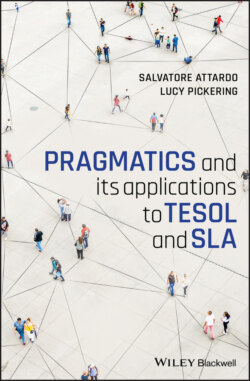Читать книгу Pragmatics and its Applications to TESOL and SLA - Salvatore Attardo - Страница 35
3.1.1 Austin and Performativity
ОглавлениеAustin is most famous for his book How to Do Things with Words. The book introduces two crucial concepts of the philosophy of language: performativity and the distinction between locutionary, illocutionary, and perlocutionary acts.
Performativity is at the origin of the speech act theory of language. Essentially, it boils down to the realization that some utterances are neither true nor false, but rather they do something (they perform an action, hence performative). For example, if when Attardo asked Pickering to marry him she had replied “Your utterance is false” (or “true” for that matter), it would literally make no sense. The question is not whether the utterance is either true or false, it is neither, but rather whether it is felicitous or not (i.e., in this case, since it is a question, is it a valid question?).2 Now consider another example, suppose that in a court of law the bailiff had put on the judge’s robe and sat in his/her chair, banged the gavel, and so on and said to the defendant “I sentence you to ten days in jail.” Since the bailiff is not a judge, the utterance would be infelicitous. Conversely, if the judge is a judge, in the right court of law, speaking at the right point of a trial, and so on, then the utterance is felicitous. So, performative utterances depend for their felicity on felicity conditions, much like the truth of a sentence depends on truth conditions (see Section 1.1.2).
Performative sentences thus are sentences that make something happen by virtue of their having been uttered (in the right, felicitous conditions): promising, threatening, christening, wedding, betting, sentencing, declaring war, check-mating, calling a player out in baseball, and so on are all examples of performatives.
Austin proposes three criteria to distinguish performatives from constatives (i.e., regular sentences): (1) the presence of an explicit performative verb, such as I hereby christen this ship the Nautilus; (2) the presence of felicity conditions vs. truth conditions; and (3) the fact that performatives perform an action, whereas constatives state or describe a state of affairs/event. However, the distinction proved to be too complex to maintain (Austin, 1962, pp. 94, 133, 146–147). Austin concludes that all speech acts are both constatives and performatives. This was his crucial breakthrough: each speech act consists of several different actions.
In the process of assessing the distinction between performatives and constatives, Austin elaborated the speech act theory of language: each utterance consists of three separate actions, which he labels the locutionary, illocutionary, and perlocutionary acts.
Locutionary act: The act of saying something (so the phonetic production of the sounds, the fact of saying the words, referring to a specific something with them, etc.).
Illocutionary act: What the speaker is trying to accomplish with the utterance or the way the utterance should have been taken. For example, the fact that saying something commits you to it. Further examples are asking a question, betting, promising, swearing, advising, and naming; thus, we speak of the illocutionary force of the sentence to mean the interactional purpose of the utterance.
Perlocutionary act: The effect the utterance has on its audience or the consequences of the speech act. Examples are becoming scared, persuaded, threatened, amused, bored, happy, and so on. Perlocutionatry acts also include the intended effects on the audience (1962, p. 101), meaning that one may succeed or fail to achieve one’s intended perlocutionary goal. For example, I may tell a child that there is a monster in the basement with the perlocutionary goal of stopping them from going there, but fail to reach that goal when the child enters the basement out of curiosity.
A clarification is necessary, at this point: as the term “speech act” and the “ordinary language philosophy” moniker indicate, the whole idea of speech acts, performativity, and so on originates very much within a linguistic context. However, there is no reason to restrict speech acts to language. I may refuse an offer or deny a proposition by shaking my head left-to-right (Western culture) or with a chin-lift (Mediterranean cultures). The reader will easily come up with plenty of examples in which a gesture clearly expresses a proposition and hence is a speech act. Even further, actions may convey propositions. For example, opening one’s hands to show that they are empty or bidding at an auction by raising a paddle or other gestures.
